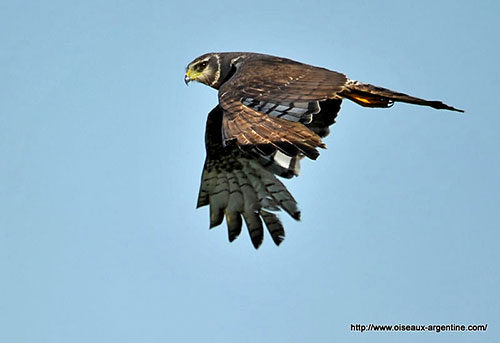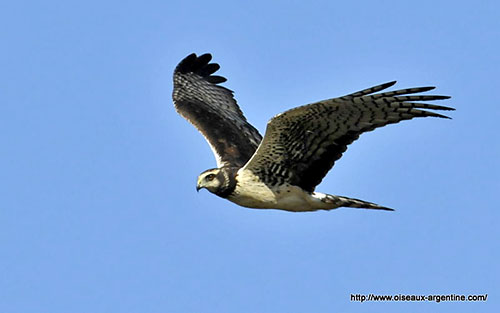
Fr: Busard de Buffon
Ang: Long-winged Harrier
All: Weißbrauenweihe
Esp: Aguilucho de Azara
Ita: Albanella alilunghe
Nd: Buffons Kiekendief
Sd: långvingad kärrhök
Photographers:
John Anderson
John Anderson Photo Galleries
Eduardo Andrés Jordan
MIS AVES – AVES DE ARGENTINA
Philippe and Aline Wolfer
OISEAUX D'ARGENTINE
Text by Nicole Bouglouan
Sources:
HANDBOOK OF THE BIRDS OF THE WORLD Vol 2 by Josep del Hoyo-Andrew Elliot-Jordi Sargatal - Lynx Edicions - ISBN: 8487334156
A GUIDE TO THE BIRDS OF COLOMBIA by Steven L. Hilty and William L. Brown - Princeton University Press – ISBN 069108372X
BIRDS OF VENEZUELA by Steven L. Hilty – Ed. Christopher Helm – ISBN: 0713664185
RAPTORS OF THE WORLD by James Ferguson-Lees et David Christie - Helm Identification Guides – ISBN: 0713680261
Neotropical Birds – Cornell Lab of Ornithology
Arthur Grosset's Birds (Arthur Grosset)
The Online Guide to the Animals of Trinidad and Tobago
Long-winged Harrier
Circus buffoni
Accipitriformes Order – Accipitridae Family
INTRODUCTION:
The Long-winged Harrier is a bird of prey of the grasslands of South America where it flies low over the ground when hunting. It feeds on several animal prey such and small mammals, reptiles, amphibians and birds. It typically nests on the ground among grasses, like other harrier species.
The Long-winged Harrier has large range in which it is described as “local”. It is affected by degradation of wetland areas, but the species is not globally threatened for the moment.
DESCRIPITION OF THE BIRD:
Biometrics:
Length: 46-60 cm
Wingspan: 120-155 cm
Weight: M: 390-464 g – F: 400-645 g
The Long-winged Harrier has long wings and long, narrow, rounded tail. Its plumage is variable and two morphs are described, a light or normal morph and a dark morph. Both have an owl-like facial disk, the flight-feathers are heavily barred black and the tail shows several dark bands. The rump is white, but less distinct in dark morph.

The adult male of light morph has black back, head and pectoral band. On the upperwing, coverts and flight-feathers are silvery-grey, the latest with black bars. The white-tipped tail shows several dark bands. The rump is white.
On the underparts, breast and belly are white with scattered dark spots, especially on flanks. The underwing is brownish-grey with black barring and black tips to flight-feathers.
On the black head, forehead, supercilium, face and throat are white. The eyes may show a black eyering, more or less distinct. The facial disk is enhanced by short, white streaks.
The bill is black and the cere is blue-grey. The eyes are yellow. Legs and feet are pale orange-yellow.
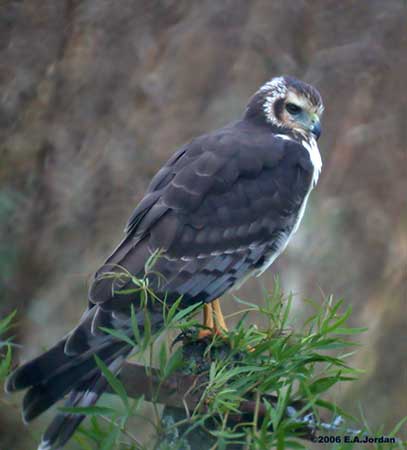
The adult female of light morph has similar plumage pattern, but the black areas are browner, the throat is mottled tawny and the facial pattern is buff. There are brown streaks on the underparts but the thighs are tawny to buff. She is usually larger than male. The eyes are rufous-brown.
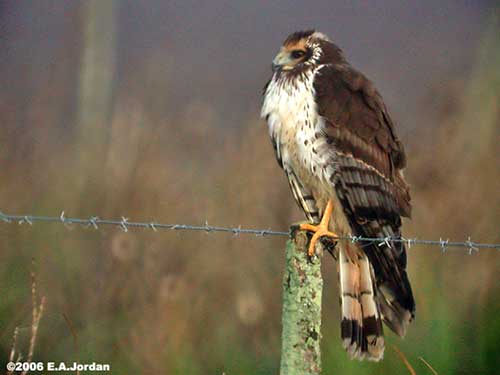
The immature of light morph resembles female, but the underparts are more broadly streaked brown. The eyes are brown, but mostly yellow-brown in young male.
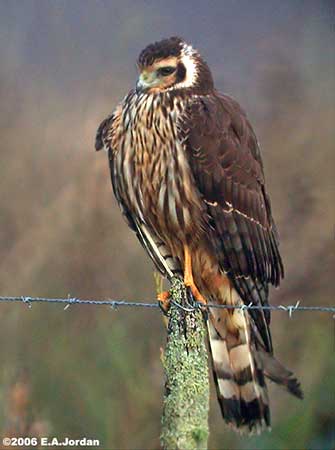
Both adults of dark morph have sooty black body plumage with rump barred white. They may be slightly browner below, with more chestnut thighs, and sometimes vent in females.
The pattern of wings and tail is similar to light morph, and face pattern is typically white or buff.
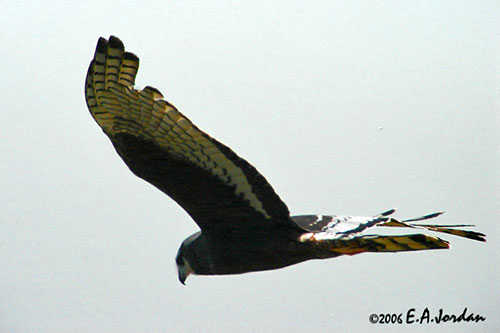
The juvenile of dark morph is mainly blackish-brown above with rufous edges to feathers. The underparts are variably streaked sooty and white, but thighs and vent are rufous.
RANGE:
The Long-winged Harrier is found in Colombia, E to the Guianas, Trinidad, and S to Brazil, Paraguay, N and C Argentina and Uruguay.
This species is non-breeding visitor in Bolivia and N Brazil. It has been recorded in E Panama.
It is usually local in north and more widespread farther south.
HABITAT:
The Long-winged Harrier frequents large marshes, small lagoons with tall emergent vegetation, wet grasslands, and also ricefields depending on the range. It often nests in open cultivated areas, but it prefers natural grasslands.
It can be seen close to wooded areas or in drier habitats outside breeding season.
It is usually found below 700 metres of elevation, occasionally higher, but rarely.
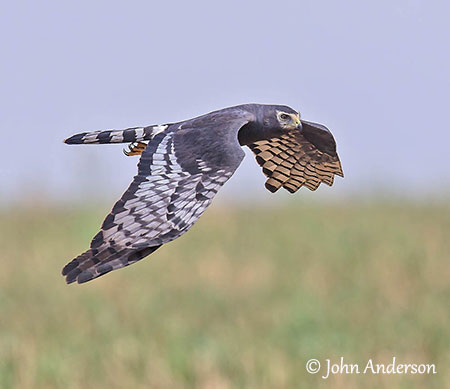
CALLS AND SONGS: SOUNDS BY XENO-CANTO
The Long-winged Harrier is quiet away from the nest, but when alarmed or during nest defence, it gives rapid series of high-pitched notes. During courtship, it produces a plaintive squeal.
BEHAVIOUR IN THE WILD:
The Long-winged Harrier feeds mainly on small mammals, but it also takes reptiles, amphibians and small birds, and generally both terrestrial and aquatic prey.
It hunts during the day between sunrise and sunset. It flies over the ground in wetlands, looking for prey and flying less than 5 metres above the ground. Once a prey is located, it drops down to catch it with the claws.
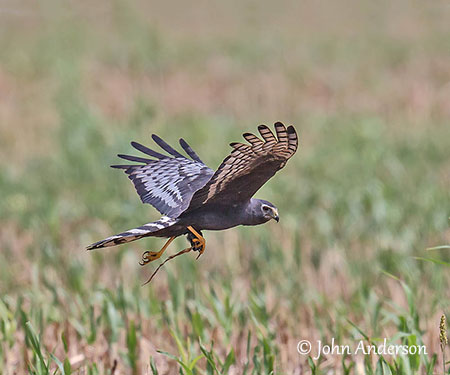
During the breeding season, both mates perform the aerial transfer of prey while flying. The female flies slightly lower and behind the male that drops the prey, in order she can receive it in her claws.
Like other harriers, this species nests on the ground in grasses.
The Long-winged Harrier is partly migratory, at least in southernmost populations. But this behaviour requires more information.
This species flies low over the ground when hunting. The flight is slow with continuous wingbeats interspersed with occasional glides. It may fly back and forth with head down while searching for prey.
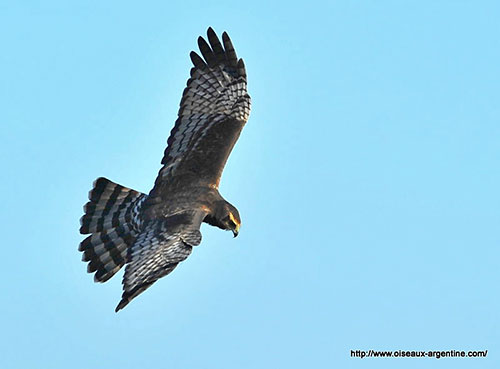
REPRODUCTION OF THIS SPECIES:
The breeding season varies according to the range, but usually occurs during the summer months (September/January in Argentina).
The Long-winged Harrier builds the nest on the ground, usually a platform made with rushes and grasses, sometimes up to 3 metres above the ground or lower, less than 1 metre above standing water.
The female lays 2-4 eggs (3-4 in Argentina). No more information.
PROTECTION / THREATS / STATUS:
The Long-winged Harrier is widespread, although it is described as “local” throughout its large range.
The species is threatened and affected by degradation of wetlands, caused by drainage and pollution. The population is suspected to be declining due to this problem, but the species is not globally threatened for the moment, and the Long-winged Harrier is currently evaluated as Least Concern.
